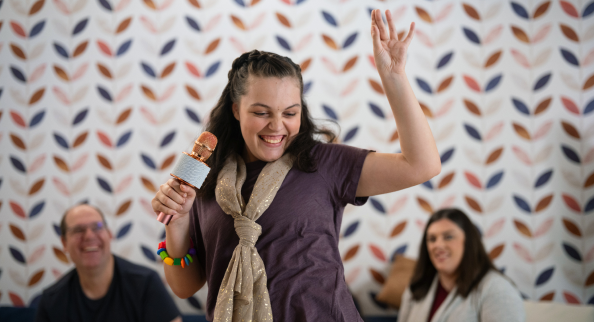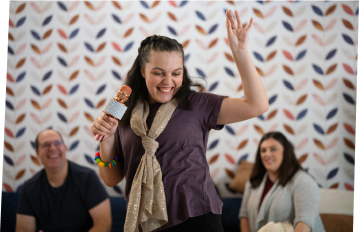Your loved one and Dravet
With Dravet syndrome, there is no one-size-fits-all path. Seizures can vary significantly from person to person, and so can mental and physical needs. Your child will have their own unique challenges and triumphs as they grow.


Look at your child as unique, and try not to compare them to how other kids are doing. Just remember they're going to have strengths, and you can build on those.
—Erin, mom of Mia, age 16
Key areas of growth
With all of the accommodations and tools that exist, your child’s strengths can be your focus. We identified areas of growth in those with Dravet syndrome by asking caregivers about their loved ones' development. Under each of the areas below, find tips from caregivers about what helped their loved ones reach new milestones:
 Communication
Communication
Many people with Dravet syndrome experience delayed language and speech. Sometimes, people don’t speak at all, or use limited words. Nonverbal methods can help people communicate in ways that work best for the individual.
Tips from other caregivers:
- Consult a speech pathologist or speech therapist
- Practice singing songs together, like the ABCs
- Give your loved one a voice with an Augmentative and Alternative Communication (AAC) Device, which speaks out loud when a user selects letters, words, sentences, or images
- Make a list of important words you’d want your family to learn in sign language, and look up how to sign them
- Identify objects with your child using photos
- Take note of how your loved one communicates with gestures, body language, and facial expressions
What we want to do for our kids is we want to teach them how to have a voice. And if they can't verbally have a voice, we need to give them a way to do it.
—Melanie, mom of Rosie, age 3
 Social skills
Social skills
Because of communication issues, developmental delays, and other disabilities, people with Dravet syndrome may need extra support socially. Encourage social time with other children, whether it be with friends, cousins, or siblings.
Tips from other caregivers:
- Look into Early Intervention (EI) programs, daycares, or schools that specialize in teaching children with developmental delays
- Ask your healthcare team or therapist about toys or devices that can help with interactive play for your loved one’s developmental stage
- Lean into the things your child loves. If they love singing, have the family over for a sing-along
- Research local events and groups specifically for children with special needs, which can give your loved one a safe space to socialize
- Practice social skills at home, such as making eye contact or saying “hello”
- Play games that involve taking turns with others. This gives your child a goal and lets them know they are able to take a break once they accomplish it
- Make the most of playdates at home, since it’s a familiar place for your child
We worked really hard over the years to teach her to make eye contact, say hello, and to say things like ‘How are you? My name is Mia.’ As she's gotten older, she [has] really started to blossom socially.
—Erin, mom of Mia, age 16
 Independence
Independence
Building a sense of independence in your loved one can come in many forms; from asking them to help out with a simple chore, to giving them the freedom to do something on their own.
Tips from other caregivers:
- Give your loved one the freedom at home to explore and interact with their environment safely without limitations
- Work on small tasks that can give them a sense of independence, such as zipping up their own jacket, or brushing their own teeth
- If your child has any instability with walking or balance, SMO (supramalleolar orthoses) braces can help them gain ankle support and walk independently for longer distances
- When loved ones are old enough, give them a purse or bag that they can keep essential items in, like rescue medication
- If you’re able, organize events where you can leave them with friends or family, so that they feel more comfortable on their own
- As they get older, consider programs or classes intended to prepare them for employment
She takes an employment prep class, which has been really cool. They teach them skills, and do jobs for the teachers, like delivering things. She feels like she's taken over the world.
—Erin, mom of Mia, age 16
Support for adults with Dravet syndrome
Support and resources are important at any age. Connect with other parents and caregivers of adults with Dravet syndrome and get additional support through the Dravet Syndrome Foundation.
Do you have a loved one with Dravet syndrome growing into adulthood? Use our C.A.R.E. (Caring for Adults with Rare Epilepsy) Binder to navigate the journey from pediatric to adult care. It includes:
- Step-by-step checklists to prepare for long-term care
- Video messages with advice from healthcare professionals and families of those with rare epilepsy


We hear a lot about their disabilities and how our children are going to be limited, but we don't talk enough about how much they can thrive.
—Danitza, mom of Giovanni, age 4
Moving forward: Goals for the future
It is normal for your goals with Dravet syndrome to change over time based on your loved one’s current strengths and struggles. Here are some hopes for the future that other caregivers have for their loved ones:
Happiness
I am hopeful that she might be able to enjoy an appropriate school environment one day. I am just excited to see the person that she grows into. And I think my biggest hope for her is that she's happy.
—Melanie, mom of Rosie, age 3
Independence
My hopes for Giovanni's future is that he will thrive and be as independent as possible, whatever that looks like. If he's able to bathe himself, or take care of himself with daily activities, those are our goals.
—Danitza, mom of Giovanni, age 4
Growth
My overall hope for Mia is for her to have a great quality of life. I want her to continue to grow, be proud of who she is, and shine for the world. She wants to do a lot of things and I would love for her to be able to do those things the best that she can.
—Erin, mom of Mia, age 16
Get support and inspiration from other parents and caregivers from Shine Forward With Dravet

